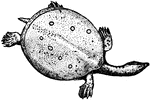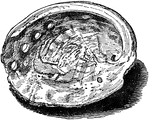
Abalone
"A general name on the Pacific coast of the United States for marine shells of the family Haliotidæ…
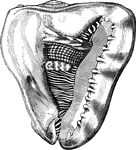
Cassis tuberosa
"The large Helmet-Shells, of the genus Cassis are used in the manufacture of cameos."…

Harp-shell
"Abundant on the shores of Mauritius and of the neighboring islands. For this and analogous species,…

Wentle-trap
"The shell is mostly white and lustrous; turreted and many-whorled; the animal has a proboscis-like…
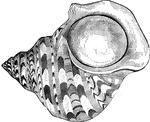
Top shell
"The top shell, T. marmoratus, has a turbinated solid shell, with convex whorls." — Goodrich,…

Trochus imperialis
"Found only at New Zealand, and here it is rare; the shell is very beautiful, the whorls rising in a…

Marine trumpet-shell
"The marine trumpet or Triton's shell, Triton variegatus, is elegantly variegated with red…

Ear-shell
"In these, which are called Ear-Shells, the animal has a shrt muzzle and two branchial plumes;…
Elephant's tooth
"It has an aperture at each end; the animal inhabiting it is of a cylindrical form, and inclosed in…

Mediterranean umbrella-shell
"These animals, called Umbrella-Shells, are furnished with a shell, which, however, is often…
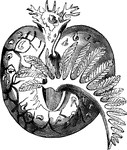
Leach's bursatella
"The descriptions of it are very obscure; it appears to be destitute of shell, the body globular, the…
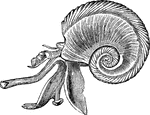
Atlanta peronil
"Found in the vicinity of the Canary Isles, the shell is minute, glassy, and compressed." — Goodrich,…

Limacina, rostralis
"The shell of Limacina rostralis resembles a small nautilus in form." — Goodrich, 1859
Accessory Valve
"Small additional valves, as those placed near the umbones of the Genus Pholas among mollusks."-Whitney,…
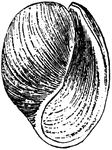
Acera
"A genus of mollusks, of the familiy bullidæ or Tornatellidæ, belonging to the tectibranchiate…

Agate Shell
"A genus of land-snails, of the family Helicidæ. Typified by the large agate-shells of Africa."-Whitney,…
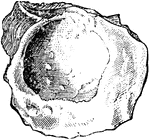
Aetheria semilunata
"A genus of bivalve mollusks, of the family Uniondæ, found in the rivers of Africa and Madagascar."-Whitney,…
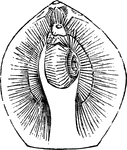
Lamp-shell
"The Lamp-Shell, Terebratula maxillata, has a smooth convex shell, the animal attached by a peduncle."…
Tube of the watering-pot shell
"The animal in this case is inclosed in a cacareous tube, the anterior extremity of whichi is closed…
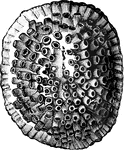
Tube of the water-pot shell magnified
"The animal in this case is inclosed in a cacareous tube, the anterior extremity of which is closed…

Panopaea australis
"The Panopaea Australis is a large analogous species, found at Port Natal, on the coast of…
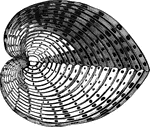
Cardium junonae
"The C. junonae is a very beautiful species. The great assemblage of the different kinds is…
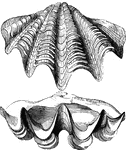
Shells of the great clam
"The Giant Clam, Tridacna gigas, is the largest of known shell-fish, the two valves sometimes…

Hippopus maculatus
"The shells of the Hippopus maculatus are smaller but are more beatiful, and are used in the…

Unio pictorium
"The unio pictorium is common in Europe, and derived its name from the fact that its shell…

Arca tortuosa
"In the Arcacea the shells are nearly equal, usually thick and furnished with a long row of reeth at…

Apple Shell
"The species are numerous, and are chiefly found in the fresh waters of tropical and subtropical countries,…

Ammonite
"Ammonite is the name for a large genus of fossil chambered shells."—(Charles Leonard-Stuart,…
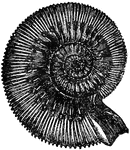
Ammonite
"Ammonite is the name for a large genus of fossil chambered shells."—(Charles Leonard-Stuart,…

Spout-Shell
"Aporrhais; A genus of gatropods with effuse channel-like lip-spines, represented by the pelican's foot…

Armor-Piercing Shell
"Armor-piercing shells are projectiles so constructed as to bore through the metallic plates with which…

Armor-Piercing Shell
"Armor-piercing shells are projectiles so constructed as to bore through the metallic plates with which…
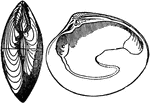
Bivalve
"Bivalves are those mollusks whose coverings consist of two concave shelly plates or valves united by…

Block and Tackle
"A Block is a pulley or a system of pulleys rotating on a pintle mounted in its frame or shell with…
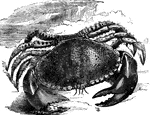
Common European crab
"These have the shell regularly rounded in front and narrowed behind; the legs are of moderate length,…
!["[The paguridae] includes the Hermit or Soldier Crab, <em>Pagurus Bernardus</em>, the abdominal portion of whose body is quite soft, forming a sort of cylindrical fleshy mass behind the shelly cephalothorax. As the comfort of the animal would be materially interfered with were this soft, worm-like appendage exposed to be grabbed at by every passing fish who might take a fancy to it, he usually seeks some shelter for its tail, and the habitation selected is generally the empty shell of some univalve mollusk." — Goodrich, 1859](https://etc.usf.edu/clipart/14900/14983/hermit-crab_14983_mth.gif)
Hermit-crab
"[The paguridae] includes the Hermit or Soldier Crab, Pagurus Bernardus, the abdominal portion…
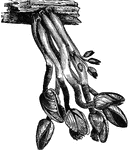
Barnacles
"The Common Barnacle, Lepas anatifera, perhaps the best-known example of the order, generally…
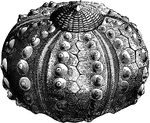
Sea-urchin without spines
"The globular crest of this animal is made up of several hundred polygonal pieces of different sizes,…
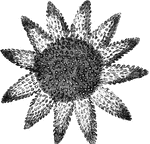
Common European sea-star
"The colors in this are variable but brilliant - red, purple, green, and white. It measures from nine…

18th Century Spanish Shell Fan
"A Fan is an instrument used by ladies to agitate the air, and cool the face, in warm weather; hence,…
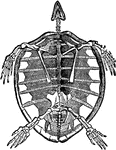
Skeleton of Turtle
"Turtle is, in zoology, the popular name for any species of the Cheloniidæ. They may be distinguished…
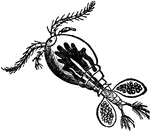
Cyclops communis Water Flea
"Water Flea is a popular name for minute aquatic Crustaceans such as daphnia, cypris, and cyclops. In…
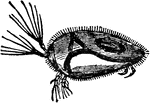
Cypris Unifasciata Water Flea
"Water Flea is a popular name for minute aquatic Crustaceans such as daphnia, cypris, and cyclops. In…

Daphnia Pulex Water Flea
"Water Flea is a popular name for minute aquatic Crustaceans such as daphnia, cypris, and cyclops. The…

Pinna
"The outer ear consists of a plate of gristle, shaped somewhat like a shell, known as the pinna, or…
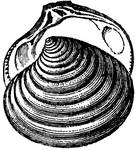
Astarte sulcata
"Astarte sulcata; In some systems of zoological classification, a family of dimyarian bi-valves, an…
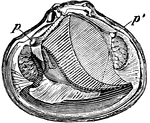
Astarte sulcata
"Astarte borealis semisulcata. p,p', anterior and posterior pedal muscle."-Whitney, 1902.

Parthenon
"The Parthenon is a celebrated temple at Athens, consecrated to Athena or Minerva, the protectress of…
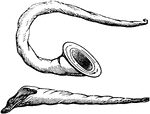
Buccina
"A kind of horn trumpet, anciently made out of a shell, the form of which is exhibited in the two specimens…

Seventeen Year Locust
The Seventeen Year Locust (Cicada septendecim) spends seventeen years underground feeding on the roots…
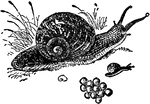
Snail
"Snail is the common name of gasteropodous mollusks. They feed chiefly on vegetable substances, though…

Triton
"One of the Nereides, Triton. A sea deity, son of Neptune and Amphrodite. His lower extremities were…
Pyxis
"A casket, a jewel-box. Quintilian produces this term as an example of catachresis, because it properly…

Peter
Peter, Peter, pumpkin eater; Had a wife and couldn't keep her; He put her in a pumpkin shell; and there…



